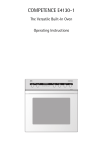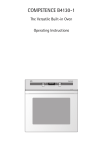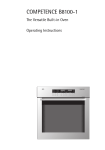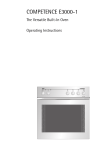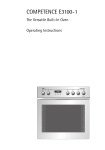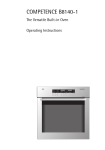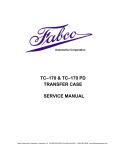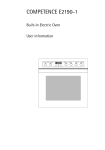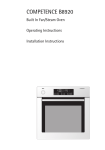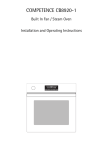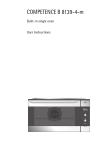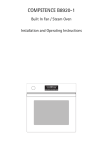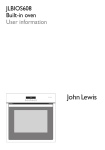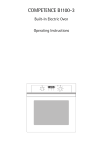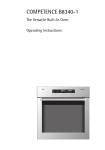Download B30001-B User manual
Transcript
COMPETENCE B3000-1 The Versatile Built-in Oven User Instructions Dear customer, Please read these operating instructions carefully. Pay particular attention to the section “Safety information” on the first few pages. Please retain these operating instructions for later reference. Pass them on to possible new owners of the appliance. The following symbols are used in the text: 1 Safety instructions Warning: Information concerning your personal safety. Important: Information on how to avoid damaging the appliance. 3 Information and practical tips 2 Environmental information 1. These numbers indicate step by step how to use the appliance. 2. ... 3. ... Printed on environmentally friendly paper. Thinking ecologically means acting ecologically ... 2 Contents Safety . . . . . . . . . . . . . . . . . . . . . . . . . . . . . . . . . . . . . . . . . . . . . . . . . . . . . . . . 5 Disposal . . . . . . . . . . . . . . . . . . . . . . . . . . . . . . . . . . . . . . . . . . . . . . . . . . . . . . 7 Description of the Appliance . . . . . . . . . . . . . . . . . . . . . . . . . . . . . . . . . . . . 8 General Overview . . . . . . . . . . . . . . . . . . . . . . . . . . . . . . . . . . . . . . . . . . . . . . . 8 Control Panel . . . . . . . . . . . . . . . . . . . . . . . . . . . . . . . . . . . . . . . . . . . . . . . . . . 8 Oven Features . . . . . . . . . . . . . . . . . . . . . . . . . . . . . . . . . . . . . . . . . . . . . . . . . . 9 Oven Accessories . . . . . . . . . . . . . . . . . . . . . . . . . . . . . . . . . . . . . . . . . . . . . . . 10 Before Using for the First Time . . . . . . . . . . . . . . . . . . . . . . . . . . . . . . . . . 11 Initial Cleaning . . . . . . . . . . . . . . . . . . . . . . . . . . . . . . . . . . . . . . . . . . . . . . . . . 11 Using the Oven . . . . . . . . . . . . . . . . . . . . . . . . . . . . . . . . . . . . . . . . . . . . . . . . Switching the Oven On and Off . . . . . . . . . . . . . . . . . . . . . . . . . . . . . . . . . . . Oven Functions . . . . . . . . . . . . . . . . . . . . . . . . . . . . . . . . . . . . . . . . . . . . . . . . Inserting the Shelf and Universal Baking Tray . . . . . . . . . . . . . . . . . . . . . . . 12 12 13 15 Uses, Tables and Tips . . . . . . . . . . . . . . . . . . . . . . . . . . . . . . . . . . . . . . . . . . . Baking . . . . . . . . . . . . . . . . . . . . . . . . . . . . . . . . . . . . . . . . . . . . . . . . . . . . . . . . Baking Table . . . . . . . . . . . . . . . . . . . . . . . . . . . . . . . . . . . . . . . . . . . . . . . . Tips for Baking . . . . . . . . . . . . . . . . . . . . . . . . . . . . . . . . . . . . . . . . . . . . . . Pies and Gratin Table . . . . . . . . . . . . . . . . . . . . . . . . . . . . . . . . . . . . . . . . . Frozen Ready Meals Table . . . . . . . . . . . . . . . . . . . . . . . . . . . . . . . . . . . . . Roasting . . . . . . . . . . . . . . . . . . . . . . . . . . . . . . . . . . . . . . . . . . . . . . . . . . . . . . Roasting table . . . . . . . . . . . . . . . . . . . . . . . . . . . . . . . . . . . . . . . . . . . . . . Grilling . . . . . . . . . . . . . . . . . . . . . . . . . . . . . . . . . . . . . . . . . . . . . . . . . . . . . . . Grilling Table . . . . . . . . . . . . . . . . . . . . . . . . . . . . . . . . . . . . . . . . . . . . . . . Preserving . . . . . . . . . . . . . . . . . . . . . . . . . . . . . . . . . . . . . . . . . . . . . . . . . . . . . 16 16 18 20 21 22 23 25 27 27 28 Cleaning and Care . . . . . . . . . . . . . . . . . . . . . . . . . . . . . . . . . . . . . . . . . . . . . Exterior of the Appliance . . . . . . . . . . . . . . . . . . . . . . . . . . . . . . . . . . . . . . . . Oven Interior . . . . . . . . . . . . . . . . . . . . . . . . . . . . . . . . . . . . . . . . . . . . . . . . . . Accessories . . . . . . . . . . . . . . . . . . . . . . . . . . . . . . . . . . . . . . . . . . . . . . . . . . . . Shelf Support Rails . . . . . . . . . . . . . . . . . . . . . . . . . . . . . . . . . . . . . . . . . . . . . Oven Lighting . . . . . . . . . . . . . . . . . . . . . . . . . . . . . . . . . . . . . . . . . . . . . . . . . . Oven Door . . . . . . . . . . . . . . . . . . . . . . . . . . . . . . . . . . . . . . . . . . . . . . . . . . . . . Oven Door Glass . . . . . . . . . . . . . . . . . . . . . . . . . . . . . . . . . . . . . . . . . . . . . . . 30 30 30 30 31 32 33 34 3 What to do if ... . . . . . . . . . . . . . . . . . . . . . . . . . . . . . . . . . . . . . . . . . . . . . . . 36 Technical Data . . . . . . . . . . . . . . . . . . . . . . . . . . . . . . . . . . . . . . . . . . . . . . . . 37 Oven Interior Dimensions . . . . . . . . . . . . . . . . . . . . . . . . . . . . . . . . . . . . . . . . 37 Regulations, Standards, Directives . . . . . . . . . . . . . . . . . . . . . . . . . . . . . . . . . 37 Installation Instructions . . . . . . . . . . . . . . . . . . . . . . . . . . . . . . . . . . . 39 Safety Instructions for the Installer . . . . . . . . . . . . . . . . . . . . . . . . . . . . . . . . 39 Guarantee Conditions . . . . . . . . . . . . . . . . . . . . . . . . . . . . . . . . . . . . . 43 Customer Service Centres . . . . . . . . . . . . . . . . . . . . . . . . . . . . . . . . . 45 Index . . . . . . . . . . . . . . . . . . . . . . . . . . . . . . . . . . . . . . . . . . . . . . . . . . . . . . . . . 46 Service . . . . . . . . . . . . . . . . . . . . . . . . . . . . . . . . . . . . . . . . . . . . . . . . . . . . . . . 47 4 1 Safety Electrical Safety • The appliance may only be connected by a registered specialist. • In the event of any faults or damage to the appliance: remove fuses or switch off. • It is not permissible to clean the appliance with a steam or high pressure cleaner for safety reasons! • Repairs to the appliance may only be carried out by specialists. Repairs carried out by inexperienced persons may cause injury or serious malfunctioning. If your appliance needs repairing, please contact your local AEG Service Force Centre or your specialist dealer. Child Safety • Never leave children unsupervised when the appliance is in use. Safety whilst Using • This appliance is intended to be used for cooking, frying and baking food in the home. • Take care when connecting electric appliances to sockets nearby. Do not allow connecting leads to come into contact with hot rings or to catch beneath the hot oven door. • Warning: Risk of burns! The interior of the oven becomes hot during use. • Using ingredients containing alcohol in the oven may create an alcohol-air mixture that is easily ignited. In this case, open the door carefully. Do not have embers, sparks or naked flames in the vicinity when opening the door. 5 To Avoid Damaging Your Appliance • Do not line your oven with aluminium foil and do not place a baking tray or dish on the oven floor, otherwise the oven enamel will be damaged by the resulting build up of heat. • Juice from fruit that drips from baking trays will leave marks that cannot be removed. For very moist cakes, use the universal baking tray. • Do not put any weight on the oven door when it is open. • Never pour water directly into the hot oven. The enamel may be damaged. • Using force, especially on the edges of the front glass panel, may break the glass. • Do not store inflammable objects in the oven. They may ignite when the oven is switched on. • Do not store moist food in the oven. The enamel may be damaged. 6 2 Disposal Disposing of the packaging material All materials used can be fully recycled. Plastics are marked as follows: • >PE< for polyethylene, as used for the outer wrapping and the bags inside. • >PS< for polystyrene foam, e.g., as used for the padding materials. They are completely free of CFCs. Disposal of old appliances 1 Warning: Before disposing of old appliances please make them inoperable so that they cannot be the source of danger. To do this, disconnect the appliance from the mains supply and remove the mains lead. To protect the environment, it is important that worn out appliances are disposed of in the correct manner. • The appliance must not be disposed of with household rubbish. • You can obtain information about collection dates or public refuse disposal sites from your local refuse department or council. 7 Description of the Appliance General Overview Control Panel 8 Oven Features All of the interior walls of the oven are coated in a special enamel (catalytic coating). Oven steam vent Steam from the oven is fed out between the upper door edge and the control panel. 9 Oven Accessories Combination shelf For dishes, cake tins, items for roasting and grilling. Universal baking tray For moist cakes, juicy roasts or as a baking sheet or collecting vessel for fat. 10 Before Using for the First Time Initial Cleaning Before using the oven for the first time you should clean the oven floor. 1 Caution: Do not use any caustic, abrasive cleaners! The surface could be damaged. 3 To clean metal fronts use commercially available cleaning agents. 1. Turn the oven function switch to oven lighting L. 2. Remove all accessories and the shelf support rails and wash them with warm water and washing up liquid. 3. Then wash the oven floor with warm water and washing-up liquid, and dry. 4. Wipe the front of the appliance with a damp cloth. 11 Using the Oven Switching the Oven On and Off 1. Turn the “oven functions” switch to the required function. 2. Turn the “temperature selection” switch to the required temperature. The yellow oven power indicator will remain on while the oven is in use. The red temperature pilot light comes on while the oven is heating up. 3. To switch off the oven turn the “oven functions” switch and the “temperature selection” switch to the off position. 3 12 Cooling fan The fan comes on automatically when the oven is in use in order to keep the surfaces of the appliance cool. Once the oven has been switched off the fan continues running to cool down the appliance and then switches itself off automatically. Oven Functions The oven has the following functions: L Oven lighting With this function you can illuminate the oven interior, e.g., for cleaning. The heating element is not in use. H Hot air For baking on up to two shelf positions. Set oven temperatures 20-40 °C lower than when using conventional. Conventional is used and in addition the fan is switched on. O Conventional For baking and roasting on one level. The conventional heating elements are in use. Ü Bottom heat For crisping and browning cakes with crispy bases. The bottom heating element is in use. A Defrost To begin to thaw and to defrost such items as flan, butter, bread, fruit or other frozen foods. For this function the fan operates without heating. F Grill For grilling flat foods placed on the middle of the shelf such as steaks, escalopes or fish, or for toasting. The grill heating element is in use. Z Dual grill For grilling larger quantities of flat foods such as steaks, escalopes or fish, or for toasting. Top heat and the grill heating element are in use. 13 I Rotitherm For roasting larger pieces of meat or poultry on one level. This function is also suited to cooking foods au gratin and browning. The grill heating element and fan operate alternately. 14 Inserting the Shelf and Universal Baking Tray 3 Anti-tip device All slide-in units have a small bulge on the left and right. This bulge is an anti-tip device and must always point to the rear of the oven. Tray or universal baking tray: The anti-tip device must point towards the rear of the oven. ✘ Inserting shelf: Insert the shelf unit with both guide rails pointing upwards. The anti-tip device must point downwards and be positioned to the rear of the oven compartment. Inserting shelf and tray: When the shelf unit and universal baking tray are used together, carefully place the shelf anti-tip device in the bulges on the tray. 15 Uses, Tables and Tips Baking For baking use the hot air H or conventional O oven function. Baking tins • Coated baking tins and tins made of dark metal are suitable for conventional O heat. • For hot air H baking tins made of light metal are also suitable. Shelf positions • Baking with conventional O is only possible on one shelf position at a time. • Using hot air H you can bake dry items and biscuits on 2 baking trays simultaneously. 1 Baking tray Shelf position 3 2 Baking trays: Shelf positions 1 and 4 16 1 Baking tin: Shelf position 1 3 General information • Always count the shelf positions from the bottom upwards. • Insert baking trays with the sloped edge to the front! • Always place cake tins in the middle of the shelf. • You can also bake with two tins at the same time using conventional O or hot air H by placing the tins side by side on the shelf. There is no significant increase in baking time. Notes on the baking tables In the tables you will find information on temperatures, cooking times and shelf positions for a selection of dishes. • The temperatures and cooking times are for guidance only since these are dependent on the mixture, quantity and cake tin used. • We recommend that you use the lower temperature initially and only select a higher temperature if necessary, e.g., if more browning is required or the cooking time is too long. • If you cannot find specific information for one of your own recipes, use information given in a similar recipe for guidance. • When cakes are baked on trays or in tins on more than one oven position at once the baking time may be increased by 10-15 minutes. • Items that might drip (e.g., pizzas, fruit flans) should only be prepared on one level. • Variations in the height of the item to be baked can lead to different degrees of browning at the start of baking. In this case please do not change the temperature setting. Differences in the degree of browning will balance out during baking. 2 For longer cooking times switch off the oven approx. 10 minutes before the end of the cooking time to make use of the residual heat. Unless otherwise stated, the information in the tables assumes starting with a cold oven. 17 Baking Table Hot air H Type of cake or pastry Shelf position from bottom Temp. ºC Conventional O Shelf position from bottom Temp. ºC Time for both functions Hrs.: Mins. Cakes in cake tins Ring-shaped or bowl-shaped cakes 1 150-170 1 160-180 0:50-1:10 Madeira cake/ king cake 1 140-160 1 150-170 1:10-1:30 Sponge cake 1 140-160 2 160-180 0:25-0:40 Shortcrust pastry flan base 3 170-180 2 190-2101 0:10-0:25 Sponge flan base 3 150-170 2 170-190 0:20-0:25 Covered apple flan 1 150-170 1 170-190 0:50-1:00 Savoury flan (e.g., quiche lorraine) 1 160-180 1 190-210 0:30-1:10 Cheesecake 1 140 -160 1 170-190 1:00-1:30 Plaited roll/ring 3 160-170 3 170-190 0:30-0:40 Fruit loaf 3 160-1701 3 160-1801 0:40-1:00 Bread (rye bread) initially .....................................then 1 180-2001 140-160 2 2501 160-180 0:20 0:30-1:00 Cream puffs/eclairs2 3 160-1701 3 190-210 0:25-0:40 Swiss roll 3 150-1701 3 180-2001 0:10-0:20 apple crumbles cake3 3 150-160 3 170-190 0:20-0:40 Butter cake/sugar cake, sugar-topped cakes 3 160-1701 3 190-2101 0:15-0:30 Baking on baking trays 18 Hot air H Type of cake or pastry Shelf position from bottom Temp. ºC Conventional O Shelf position from bottom Temp. ºC Time for both functions Hrs.: Mins. Fruit flan (with a yeast dough/ sponge base) 3 140-160 3 170-190 0:25-0:50 Fruit flan on shortcrust pastry base2 3 150- 170 3 170-190 0:40-1:20 Tarts with delicate toppings (e.g. curd cheese, cream.) - - 3 170-190 0:40-1:20 Pizza (with deep topping)2 1 180-200 1 190-2101 0:30-1:00 Pizza (thin) - - 1 230-3001 0:10-0:25 Unleavened bread - - 1 275-3001 0:08-0:15 Flat sweet or savoury pies 1 180-200 1 210-230 0:35-0:50 Shortcrust biscuits3 3 150-160 3 170-1901 0:06-0:20 Small piped biscuits3 3 140-150 3 160-180 0:10-0:40 Sponge fingers3 3 150-160 3 170-190 0:15-0:20 Meringues 3 80-100 3 100-120 2:00-2:30 Macaroons 3 100-120 3 120-140 0:30-0:60 Small pastries made with yeast dough 3 150-160 3 170-190 0:20-0:40 Small pastries made with puff pastry 3 170-1801 3 190-2101 0:20-0:30 Bread rolls 3 170-1901 3 180-2201 0:20-0:35 Biscuits 1) Pre-heat the oven 2) Use the combination/fat tray or the fat tray alone 3) Baking on 2 levels possible Information printed in bold type indicates the preferred oven function or temperature 19 Tips for Baking Baking result Possible cause The cake is underWrong shelf position cooked at the bottom The cake collapses (is sticky, soft in the middle, damp patches) Cake is too dry Cake is unevenly browned Baking time too long 20 Solution Insert the cake at a lower shelf position Baking temperature too high Set to a lower temperature Baking time too short Increase baking time Baking times may not be reduced by using a higher baking temperature Too much liquid in mixture Next time use less liquid. Check that you have beaten the mixture for the correct length of time, particularly when using a food-processor. Baking temperature too low Set a slightly higher baking temperature next time Baking time too long Reduce baking time Baking temperature too high and cooking time too short Set to a lower temperature and increase cooking time Mixture is spread unevenly Spread mixture evenly on the baking tray Temperature too low Set a slightly higher baking temperature next time Pies and Gratin Table Conventional O Shelf position from bottom Temp. °C Rotitherm I Shelf position from bottom Time Temp. °C Hrs: Mins. Pasta bake 1 180-200 1 160-170 0:45-1:00 Lasagne 1 180-200 1 160-170 0:25-0:40 Vegetables au gratin1 1 200-220 1 160-170 0:15-0:30 Pizza baguettes1 1 200-220 1 160-170 0:15-0:30 Sweet soufflés 1 180-200 - - 0:40-0:60 Fish pies 1 180-200 1 160-170 0:30-1:00 Stuffed vegetables 1 180-200 1 160-170 0:30-1:00 1) Pre-heat the oven. Information printed in bold type indicates the preferred oven function for the dish. 21 Frozen Ready Meals Table Food to be cooked Shelf position from bottom Oven function Frozen pizza 3 Conventional O Chips1 (300-600 g) 3 Rotitherm I 3 Conventional O in accordance in accordance with the with the maker's maker's instrucinstructions tions 3 Conventional O in accordance in accordance with the with the maker's maker's instrucinstructions tions Baguettes Fruit flan Temperature Time in accordance in accordance with the with the maker's maker's instrucinstructions tions 200-220 °C 15-25 Mins. 1) Comment: Turn chips 2-3 times during cooking. 3 22 When frozen foods are used the trays inserted may distort during cooking. This is because of the large differences in temperature between the frozen item and the oven. Once the trays have cooled the distortion will disappear again. Roasting Use the rotitherm I or conventional O oven functions for roasting. Ovenware for roasting • Any heat-resistant dish is suitable for roasting (refer to the manufacturer's instructions!). • If the dish has plastic handles, check that they are heat-resistant (refer to manufacturer's instructions!). • Large roasts can be roasted directly on the universal baking tray or on the shelf with the universal baking tray underneath (e.g. turkey, goose, 3-4 chickens, 3-4 knuckles of veal). • We recommend that all lean pieces of meat should be roasted in a casserole dish with a lid (e.g. veal, marinated beef, pot roast, frozen meat.) In this way the meat will retain its juices. • In order to obtain a tasty outside crust we recommend roasting pieces of meat in a casserole dish without a lid (e.g. roast pork, lamb and mutton, meat loaf, duck, 1-2 knuckles of veal, 1-2 chickens, small fowl, roast beef, fillets, game). 3 Tip: The oven will be less dirty if you always use a dish for roasting! Shelf positions • Please see the following table for the shelf positions to be used. 23 24 3 Notes on the roasting table Information is given in the table on suitable oven functions, temperature settings, cooking times and shelf positions for various types of meat. The information is for guidance. • We recommend roasting meat and fish with a minimum weight of 1kg in the oven. • In general the conventional O oven function is particularly suitable for very lean meat such as fish or game. For all other types of meat (particularly poultry) we recommend the rotitherm I function. • To stop meat juices or fat burning onto dishes or the oven, we recommend adding a little liquid to the roasting dish. • Turn the joint as required (after 1/2 - 2/3 of the cooking time). 3 Tip: Baste large joints and poultry several times during cooking with the meat juices. This will produce better roasting results. 2 Switch off the oven approx. 10 minutes before the end of the cooking time to make use of the residual heat. Roasting table Type of meat Quantity Conventional O Weight Shelf po- Temperasition ture from botºC tom Rotitherm I Time Shelf Tempera- Hours:Mi position ture ns. from ºC bottom Beef Pot roast 1-1.5 kg 1 200-250 - - Roast beef or fillet 2:00-2:30 per cm of thickness - rare per cm of thickness 1 250-2701 1 190-200 0:05-0:06 - medium rare per cm of thickness 1 250-2701 1 180-190 0:06-0:08 - well done per cm of thickness 1 210-2501 1 170-180 0:08-0:10 Shoulder, neck ham joint 1-1.5 kg 1 210-220 1 160-180 1:30-2:00 Chop, smoked loin chop 1-1.5 kg 1 180-190 1 170-180 1:00-1:30 Meat loaf 750 g1 kg 1 170-180 1 160-170 0:45-1:00 Knuckle of pork (pre-cooked) 750 g1 kg 1 210-220 1 150-170 1:30-2:00 1 kg 1 210-220 1 160-180 1:30-2:00 1.5-2 kg 1 210-225 1 160-180 2:00-2:30 Leg of lamb, roast lamb 1-1.5 kg 1 210-220 1 150-170 1:15-2:00 Saddle of lamb 1-1.5 kg 1 210-220 1 160-180 1:00-1:30 Pork Veal Roast veal Knuckle of veal Lamb 25 Type of meat Quantity Conventional O Weight Shelf po- Temperasition ture from botºC tom Rotitherm I Time Shelf Tempera- Hours:Mi position ture ns. from ºC bottom Game Saddle of hare, haunch of hare up to 1 kg 3 220-2501 3 160-170 0:25-0:40 Saddle of venison 1.5-2 kg 1 210-220 1 160-180 1:15-1:45 Haunch of venison 1.5-2 kg 1 200-210 1 160-180 1:30-2:15 Poultry Poultry portions 4-6 pieces per 200 250 g 3 220-250 3 180-200 0:35-0:50 Chicken halves 2-4 pieces per 400500 g 3 220-250 3 180-200 0:35-0:50 Chicken, poulard 1-1.5 kg 1 220-250 1 170-180 0:45-1:15 Duck 1.5-2 kg 1 210-220 1 160-180 1:00-1:30 Goose 3.5-5 kg 1 200-210 1 150-160 2:30-3:00 Turkey 2.53.5 kg 4-6 kg 1 200-210 180-200 1 150-160 140-150 1:30-2:00 2:30-4:00 1-1.5 kg 2/3 210-220 2/3 160-170 0:45-1:15 Fish (steaming) Whole fish 1) Pre-heat the oven. Information printed in bold type indicates the preferred oven function for the dish. 26 Grilling To grill use the grill F oven function with temperature setting z 1 Important: Always grill with the oven door closed. 3 Always pre-heat the empty oven for 5 minutes using the grill functions! Ovenware for grilling • Use the shelf unit and universal tray together for grilling. Shelf positions • For grilling flat foods you should mainly use the 4th shelf position from the bottom. Notes on the grilling table The grilling times are only for guidance and will vary depending on the type and quality of meat or fish. • Grilling is particularly suitable for flat pieces of meat and fish. • Turn the food halfway through grilling. Grilling Table Food for grilling Shelf position from bottom Grilling time 1st side 2nd side Rissoles 4 8-10 mins. 6-8 mins. Fillet of pork 4 10-12 mins. 6-10 mins. Grilled sausages 4 8-10 mins. 6-8 mins. Beef fillet steaks, veal steaks 4 6-7 mins. 5-6 mins. Fillet of beef, sirloin (approx. 1 kg) 3 10-12 mins. 10-12 mins. Toast 1 3 2-3 mins. 2-3 mins. Toast with topping 3 6-8 mins. - 1) Do not use the universal baking tray together with the grilling shelf unit. 27 Preserving Use the bottom heat Ü oven function for preserving. Preserving jars • For preserving use only commercially available preserving jars that are all the same size. 3 Screw-top jars, jars with a bayonet fastening and metal containers are unsuitable. Shelf positions • Use the 1st shelf position from the bottom for preserving. Notes on preserving • Use the universal tray for preserving. There is room for up to 6 preserving jars each with a capacity of 1 litre on this tray. • The preserving jars should all be filled to the same level and closed. • Position the preserving jars on the universal baking tray so that they do not come into contact with one another. • Pour about 1/2 litre of water into the universal baking tray so that there is sufficient moisture in the oven. • As soon as bubbles begin to appear in the liquid in the first jars (for 1-litre jars this takes about 35-60 minutes), switch off the oven or reduce the temperature to 100 °C (see table). 28 Preserving Table Temperature in Preserves °C Preserving time until bubbles form Mins. Continued cooking at 100 °C Standing time with oven switched off Mins. Soft fruit Strawberries, blueberries, raspberries, ripe gooseberries 160-170 35-45 - - Unripe gooseberries 160-170 35-45 10-15 - 160-170 35-45 10-15 - Carrots 160-170 50-60 5-10 60 Mushrooms 160-170 40-60 10-15 60 Gherkins 160-170 50-60 - Mixed pickles 160-170 50-60 15 - Kohlrabi, peas, asparagus 160-170 50-60 15-20 - Beans 160-170 50-60 - - Plum purée 160-170 50 45 - 6-8 Hrs. - Stone fruit Pears, quinces, plums Vegetables 29 Cleaning and Care 1 Warning: For safety reasons cleaning the appliance with a steam jet cleaner or high-pressure water cleaner is not permissible! Exterior of the Appliance Wipe the front of the appliance with a soft cloth dipped in warm soapy water. • Do not use scourers, caustic cleaners or abrasive items. • Use commercially available cleaners for metal fronts. Oven Interior Oven lighting You can switch on the oven light to make cleaning easier. Cleaning The walls that have a catalytic coating are self-cleaning. They absorb splashes of fat while the oven is in use. To support this self-cleaning process, we recommend heating the oven without any food at regular intervals. 1. Remove all slide-in items from the oven. 2. Wash the oven floor with warm water and washing up liquid, then dry it. 3. Set the oven temperature to 250 °C. 4. Switch the oven off after one hour. 5. Wipe off any remaining soiling with a soft damp sponge. 1 Important! Do not use oven sprays or abrasive cleaners. Do not use soap or other cleaning agents. Doing so can damage the catalytic surface. 3 Over time the catalytic coating can discolour slightly. This does not affect its catalytic properties. Accessories Wash all slide-in units (shelf unit, baking tray, shelf support rails etc.) after each use and dry well. Soak briefly to make them easier to clean. 30 Shelf Support Rails The shelf support rails on the left and right hand sides of the oven can be removed for cleaning the side walls. Removing the shelf support rails First pull the front of the rail away from the oven wall (1) and then unhitch at the back (2). Fitting the shelf support rails 3 Important! The rounded ends of the guide rails must be pointing forwards! To re-insert, first hook the rail into place at the back (1) and then insert the front and press into place (2). 31 Oven Lighting 1 Warning: There is a danger of electric shock! Prior to changing the oven light bulb: – Switch off the oven! – Remove the fuses in the fuse box or switch off the circuit breaker. 3 Place a cloth on the oven floor to protect the oven light and glass cover. Replacing the oven light bulb/cleaning the glass cover 1. Remove the glass cover by turning it anti-clockwise and then clean it. 2. If necessary: Replace bulb with a 40 watt, 230 V, 300 °C heat-resistant oven light bulb. 3. Refit the glass cover. 32 Oven Door The oven door of your appliance may be removed for cleaning. Removing the oven door 1. Open the oven door completely. 2. Completely fold back the brasscoloured clamping lever on both door hinges. 3. Grip the oven door with both hands on the sides and close it to about 3/4 going past the point of resistance. 4. Pull the door away from the oven (Caution: heavy!). 5. Place the door, with the outer surface downwards, on a soft, flat surface, for example a blanket, to avoid scratches. Hanging the oven door 1. With both hands take hold of the sides of the door from the side on which the handle is positioned. 2. Hold the door at an angle of approx. 60°. 3. Slide the door hinges simultaneously as far as possible into the two slots on the right and left at the bottom of the oven. 4. Lift the door up until resistance is met and then open fully. 5. Lift the brass-coloured clamping levers on both door hinges back to their original position. 6. Close the oven door. 5 33 Oven Door Glass The oven door is fitted with four glass panels mounted one behind the other. The three inner panels may be removed for cleaning. 1 Warning: Carry out the following steps only when the oven door is unhinged! When left on its hinges, the door could rise rapidly due to the lighter weight when the glass is removed and could cause injury. Removing the glass door panels Unhinge the oven door and place it on a soft, flat surface with the handle facing down. Remove the three glass panels in sequence as follows: 1. Take hold of the glass panel at the lower edge and slide it against the spring pressure in the direction of the oven door handle until it is free at the base (1). 2. Raise the panel gently at the base and pull out. Clean the glass door panels 34 Inserting the glass door panels 3 The three removeable glass panels differ in size. They will only fit into the section of the door for which they are designed. Smallest panel - at the bottom Largest panel - at the top Re-insert the three panels one at a time and in the appropriate order: 1. Insert the glass panel at an angle from above into the section of the door in which the handle is located. 2. Lower the glass panel and push against the spring on the handle side. 3. Slide it under the lower bracket towards the lower door edge as far as it will go. Each glass panel must be firmly in position and fit exactly into the door frame! Re-hang the oven door 35 What to do if ... Symptom Possible cause The oven does not heat The oven has not been up. switched on. The oven lighting does not come on. Solution Switch on the oven. The necessary settings have not been made. Check the settings. The circuit breaker (at the household fuse box) has tripped or the fuse has blown. Check the fuse. If the circuit breaker trips or the fuse blows several times, please call an approved electrician. The oven light bulb has blown. Replace the light bulb in the oven (see Cleaning and Care). If you cannot rectify the fault with the help of the information given above, please contact your local Service Force Centre. 36 1 Warning: Repairs to the appliance may only be carried out by qualified specialists. Improper repairs can give rise to significant hazards for the user. If the appliance has been used improperly, the customer service engineer's visit or that of the specialist dealer will not be free of charge, even during the warranty period. 3 Due to the cold front of your appliance the inner door glass may steam over briefly if you open the door during or shortly after baking or roasting. Technical Data Oven Interior Dimensions Height x Width x Depth Capacity (usable capacity) 31.0 cm x 41.0 cm x 41.0 cm 52 l Regulations, Standards, Directives This appliance meets the following standards: • IEC 60 335-1 and IEC 60 335-2-6 relating to the safety of electric appliances for household use and similar purposes and • IEC 60350 relating to the operating features of household electric cookers. Volte of mains supply Oven mode: Hot Air with Fan Rated Power Measured Power Temperatur rise Heating-up time Oven mode : Uppert/Lower Heat Rated Power Mesured Power Temperatur rise Heating-up time 208V 240V 1670 Watt 2250 Watt 155 K 155 K 12;0 Minutes 7,7 Minutes 1850 Watt 2250 Watt 180 K 180 K 15,4 Minutes 11,3 Minutes 37 38 Installation Instructions Installation Instructions 1 Important: The new appliance is only to be installed and connected up by an approved installer. Please observe this instruction, otherwise the warranty will not cover any damage that may occur. 1 Safety Instructions for the Installer • A device must be provided in the electrical installation which allows the appliance to be disconnected from the mains at all poles with a contact opening width of at least 3mm. Suitable isolation devices are e.g. circuit breakers, fuses (screw-type fuses are to be removed from the holder), earth leakage trips and contactors. • Anti-shock protection must be guaranteed by the installation. • The unit in which the appliance is fitted must satisfy the requirements of DIN 68930 in respect of stability. • Built-in ovens and cooking surfaces are fitted with special connector systems. They may only be combined with appliances with a matching system. • Electrical connecting box must be in cabinet below oven, or on either side of oven cabinet. 39 Installation Instructions w 1 2 40 Installation Instructions 3 41 Installation Instructions 4 5 42 Guarantee Conditions Guarantee Conditions AEG EURO-LINE APPLIANCES LENGTH OF WARRANTY: EURO-LINE WILL PAY FOR: Replacement parts and/or labour to TWO YEAR FULL WARRANTY repair defects in materials or workfrom original date of purchase, manship. Service must be provided including parts and labour, to the by an authorized Euro-Line comfirst purchaser of this appliance pany (unless advised otherwise). THIS GUARANTEE DOES NOT COVER COMMERCIAL USE. The name Euro-Line Appliances, for service matters, incorporates work performed by authorized service agents or service companies. EXCEPTIONS: EURO-LINE APPLIANCES WILL NOT PAY FOR THE FOLLOWING SERVICE CALLS: 1. To install or correct the installa- 4. To correct house plumbing. tion of an appliance. 2. To instruct the use of an appli- 5. To clean drains, filters or garbage ance. disposers. 3. To replace house fuses, re-set cir-6. To repair an appliance if it fails cuit breakers or correct house due to misuse or abuse. wiring. 43 Guarantee Conditions EURO-LINE APPLIANCES WILL NOT PAY WHEN THE FOLLOWING OCCURS: 1. Damage resulting from fires, acts of God, alteration, improper installation, or installation not in accordance with local building codes. 2. Pickup or delivery of major appliances requiring service. The appliances are designed to be repaired in the home. However, Euro-Line will not be responsible for travelling and labour costs if the customer lives in excess of 50 km/30 miles, or if the travel time is in excess of 30 minutes from the nearest service center. Any excess to this will not be covered by the warranty. In no event, will Euro-Line be responsible for incidental or consequential damages. For warranty service and parts, contact EURO-PARTS. Service will be provided during normal business hours. Should you have a service problem that is not resolved locally, contact: For Service and Parts Contact: EURO-PARTS, USA Tel: 1-800-561-4614 Fax: 1-519-528-5001 EURO-PARTS, CANADA Tel: 1-800-678-8352 Fax: 1-519-528 5001 EURO-LINE APPLIANCES 1-800-421-6332 Tel. Direct: 1-905-829-3980 Fax: 1-905-829-3985 44 Customer Service Centres Customer Service Centres AEG User Instructions & Installation Manual Service & Repair To save you time and money please have the following information ready in case you have to call for service: • Name of the dealer from whom you purchased the appliance. _______________________________________________ • Model number (shown on the rating plate) _______________________________________________ • Serial number (shown on the rating plate) _______________________________________________ • Date of purchase. _______________________________________________ You should also retain the original purchase receipt to support any claim made under the warranty. (We suggest you staple the receipt to this page). If service is required, contact the Service Center: EURO-PARTS, CANADA Tel: 1-800-561-4614 Fax: 1-519-528-500 EURO-PARTS, USA Tel: 1-800-561-4614 Fax: 1-519-528-5001 DISTRIBUTED BY: EURO-LINE APPLIANCES 2150 WINSTON PARK DRIVE, UNIT #20 OAKVILLE, ONTARIO CANADA L6H 5V1 1-800-421-6332 Tel: 905-829-3980 Fax: 905-829-3985 www.euro-line-appliances.com 45 Index A S Accessories . . . . . . . . . . . . . . . . . . . . . . . . . . 15 Safety . . . . . . . . . . . . . . . . . . . . . . . . . . . . . . . 5 Shelf . . . . . . . . . . . . . . . . . . . . . . . . . . . . . . .15 Shelf positions . . . . . . . . . . . . . . . . . . . . . . .16 Shelf support rails . . . . . . . . . . . . . . . . . . . .31 Soufflés . . . . . . . . . . . . . . . . . . . . . . . . . . . . .21 Steam vent . . . . . . . . . . . . . . . . . . . . . . . . . . . 9 B Baking . . . . . . . . . . . . . . . . . . . . . . . . . . . . . 16 Bottom heat . . . . . . . . . . . . . . . . . . . . . . . . 13 C Cleaning accessories . . . . . . . . . . . . . . . . . . . . . . . . 30 initial cleaning . . . . . . . . . . . . . . . . . . . . 11 oven . . . . . . . . . . . . . . . . . . . . . . . . . . . . . 30 oven door . . . . . . . . . . . . . . . . . . . . . . . . . 33 shelf support rails . . . . . . . . . . . . . . . . . . 31 Combination shelf . . . . . . . . . . . . . . . . . . . . 10 Control panel . . . . . . . . . . . . . . . . . . . . . . . . . 8 Conventional . . . . . . . . . . . . . . . . . . . . . . . . 13 Customer service . . . . . . . . . . . . . . . . . .45, 47 D Defrosting . . . . . . . . . . . . . . . . . . . . . . . . . . 13 Description of the appliance . . . . . . . . . . . . 8 Dishes with toppings . . . . . . . . . . . . . . . . . 21 Disposal . . . . . . . . . . . . . . . . . . . . . . . . . . . . . 7 Door . . . . . . . . . . . . . . . . . . . . . . . . . . . .33, 34 Dual grill . . . . . . . . . . . . . . . . . . . . . . . . . . . 13 G Grill . . . . . . . . . . . . . . . . . . . . . . . . . . . . . . . . 13 Grilling . . . . . . . . . . . . . . . . . . . . . . . . . . . . . 27 Guarantee . . . . . . . . . . . . . . . . . . . . . . . . . . 43 I Insert anti-tip . . . . . . . . . . . . . . . . . . . . . . . 15 O Oven accessories . . . . . . . . . . . . . . . . . . . . . . . . door . . . . . . . . . . . . . . . . . . . . . . . . . . . . . functions . . . . . . . . . . . . . . . . . . . . . . . . . light . . . . . . . . . . . . . . . . . . . . . . . . . . . . . 10 33 13 32 P Preserving . . . . . . . . . . . . . . . . . . . . . . . . . . 28 R Ready meals . . . . . . . . . . . . . . . . . . . . . . . . . 22 Repairs . . . . . . . . . . . . . . . . . . . . . . . . . . . . . . 5 Roasting . . . . . . . . . . . . . . . . . . . . . . . . . . . . 23 Rotitherm . . . . . . . . . . . . . . . . . . . . . . . . . . . 14 46 T Tables and tips . . . . . . . . . . . . . . . . . . . . . . .16 U Universal baking tray . . . . . . . . . . . . . . 10, 15 Using the oven . . . . . . . . . . . . . . . . . . . . . . .12 W What to do if . . . . . . . . . . . . . . . . . . . . . . . .36 Service The section "What do I do if...“ lists some faults that you can remedy yourself. Look there first if a fault occurs. Is it a technical fault? Then contact your nearest customer service centre. (Addresses and telephone numbers can be found under "Customer Service Centres“.) Always prepare in advance for the discussion. By doing so you will make it easier to diagnose the fault and decide whether customer service is necessary. Please make a note of the folllowing information as accurately as possible: • What form does the fault take? • Under what circumstances does the fault occur? Prior to the telephone call it is imperative that you make a note of the following appliance code numbers that are given on the rating plate: • PNC Code (9 digits), • S No Code (8 digits). We recommend that you record the code numbers here so that you always have them to hand: PNC . . . . . . . . . S No. . . . . . . . . When do you incur costs even during the warranty period? • if you could have remedied the fault using the fault table (see section "What to do if ...“), • if the customer service technician has to make several journeys because he was not provided with all the relevant information before his visit and therefore, for example, has to fetch spare parts. These multiple trips can be avoided if you prepare for your phone call as described above. 47 AEG Hausgeräte GmbH Postfach 1036 D-90327 Nürnberg http://www.aeg.hausgeraete.de © Copyright by AEG 822 947 855 -A- 270801-04 Subject to change without notice
















































